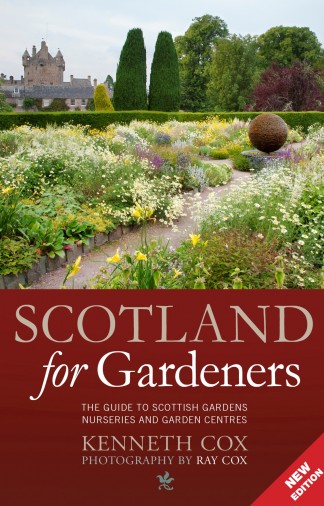492 pages 500 full colour pictures
'Scotland for Gardeners is no mere anodyne guidebook.. rather it is a comprehensive catalogue of Scotland's gardens and garden heritage...beautifully illustrated. The authors's enthusiasm is so beguiling and he packs in so much information. ... I anticipate that Scotland for Gardeners will become a constant companion and reliable source of information for garden and nursery visiting.'
Claire Fletcher, Hortus
'Occasionally a book is published which you wonder how you lived without. Scotland for Gardeners is emphatically in this category. This book is the ideal travel companion: amusing, robust and, above all, trustworthy.'
Jennie MacFie, The Sunday Herald Magazine
'Scotland for Gardeners is almost certainly the best gardening book I’ve come across in a long time'.
Gaby Soutar, Lothian Life
'With a combination of honest critique and captivating photography, Scotland for Gardeners delivers a Lonely Planet-style volume for anyone wishing to have a comprehensive guide to the landscapes of Scotland.'
Lisa Trainer The Courier
“This is an essential book for anyone with the slightest interest in Scottish Gardens...A pleasure to read and use' ”
BBC Gardens Illustrated
'The most comprehensive guide to Scottish gardens and nurseries ever published . . . For those of us who thought they knew Scotland well, it is full of wonderful surprises'
Scotland Magazine
Muthill, Crieff, PH7 4HZ
Grimmsthorpe and Drummond Castle Trust Ltd
Easter weekend (four days) then May–31 October: daily 1–6 pm; ££
Off the A823 Crieff to Gleneagles road just north of Muthill
T: 01764 681433
E: thegardens@drummondcastle.sol.co.uk
www.drummondcastlegardens.co.uk

There is nothing in Scotland to match the panorama of Scotland’s finest formal gardens, viewed from the vantage point of the upper terraces between the keep of old Drummond Castle and the more modern mansion. It is worth watching visitors’ faces break into a smile of pleasure as they take in the incredible spectacle. This is the nearest thing Scotland has to the gardens of the great French chateaux and it is almost incongruous amongst the rolling hills of Perthshire. The drive is special too, with a mile-long avenue of beech trees. Apparently John Drummond, fourth Earl of Perth, had intended for the avenue to lead all the way to the city of Perth 20 miles away. This amazing garden has been made, abandoned and re-laid several times in its history. The first formal garden was laid out in French style in 1630 but Cromwell’s vandals destroyed it and it was later overgrown by trees. John Reid, Scotland’s first horticultural author, worked at Drummond in the late seventeenth century. The Drummonds backed the Jacobite cause and were forced into exile till 1785 and the formal gardens were not re-established till the nineteenth century, when they were designed by Lewis Kennedy, who had previously worked for the Empress Josephine at Malmaison in France. He used the saltire as the main design element and created the main axis vista down the elaborate staircase, between the parterres out beyond the garden through the woods on the hillside opposite the terraces. The 12-acre rectangular formal garden is bisected by 2 diagonal lines, forming the St Andrew’s Cross with 5 parallel paths from north to south, and 2 large ponds at either end. The Victorian gardens were widely proclaimed as the best of their type and Country Life declared it the finest Edwardian garden in Britain. Two world wars were the cause of another period of decline and abandonment and it was Phyllis Astor, wife of the earl of Ancaster, who restored the gardens once again during the 1950s. The ancient yew and beech hedges and some topiary remain from Victorian days, with the fine red Japanese maples a clever addition which not only provides fiery autumn colour but, with Prunus pissardii, a startling contrast with the yellow fastigiate yew throughout the summer. The box parterres are filled withAnaphalis triplinervis, lavender and roses and there are rounded hedges surrounding Italianate statues and urns. There are two narrow terraces at the top, a steep grassed slope to a further terrace wall and then steps down to the garden itself. The choice of planting makes this formal garden attractive all year long, even in winter, as the structure is strong. What makes it so magnificent is the height of the vantage point. Of Scotland’s other formal gardens on this scale, Dunrobin shares the clifftop vista; it is a pity Pitmedden can’t boast a similar vantage point. Do walk right down to the far side of the garden, where there is an impressive kitchen garden with greenhouses and some fine mature copper beech apparently planted by Queen Victoria. It has to be admitted that walking though the gardens, though worthwhile, is somehow a bit of a let-down after the magnificence of the view from above. There is no doubt that this is one of Scotland’s must-visit gardens and it is particularly well worth a visit in late October for Autumn colour.
(DIS), DOG, WC

Preview 80 pages of the book with the full introduction and sample entries on Issuu
(Garden Media Guild)
Judges Comments: 'This book deserves a place in the glove compartment of every driver on a tour of Scotland’s gardens. It is comprehensive, featuring the large and well-known gardens plus lesser-known treasures. It has enough practical detail to make finding and visiting the gardens straightforward. It is lively and enjoyable reading too.'
Gardens which have changed ownership, closed etc since the book was published.